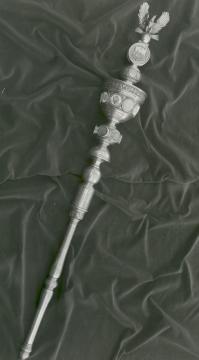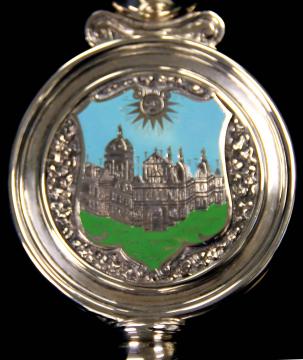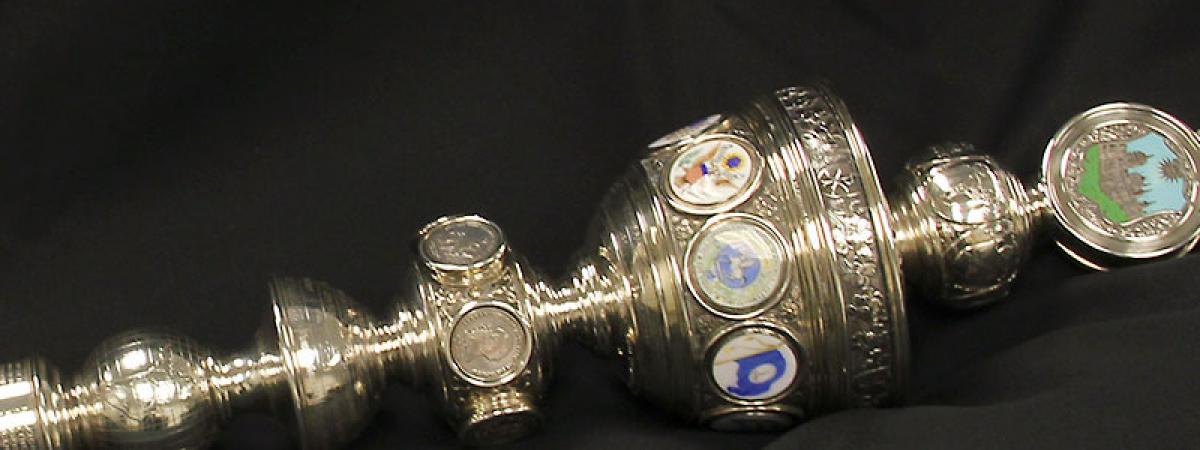
The College Mace is carried by the president of the Student Assembly at all official William & Mary convocations, such as Opening Convocation, Commencement, Charter Day, and other special convocations, as a symbol of the authority vested in the rector of the College and delegated to the president of the College. As such, it always precedes the rector and the president. The College Mace is on display in the Swem Library Special Collections Research Center along with other academic regalia when not in use for William & Mary events.
Designed and handcrafted by the Gorham Company of New York, the mace is made of sterling silver. It was given to the College by alumni and students at Charter Day on February 8, 1923, upon the 230th anniversary of the granting of the Royal Charter. The mace was stolen in 1955, presumably as part of a fraternity prank. It reappeared a few months later.12
The Sections
The College Mace is four feet long. Its sections commemorate many of the people and events in W&M's history.
- First Section: An American eagle, symbolizing liberty and freedom of thought. The eagle stands on a sheaf of arrows, symbolizing the thirteen original states. The arrows rest upon a sphere, symbolizing unity.
-

Coat of Arms on College Mace Second Section: The Coat of Arms of the College of William & Mary. On its reverse is the inscription: Collegium Gulielmi et mariae in Virginia Regia Carta Donatum Anno Domini MDCXCIII. The Coat of Arms which initially appeared on the College Mace was not the one granted to the College by the College of Heralds in 1694, but in fact the Temple seal, designed by George Wythe. After the original design for the Coat of Arms was re-discovered by President J.A.C. Chandler on a trip to London in 1929, a replacement piece was made to replace the Temple seal.
- Third Section: The coats of arms representing seven different chancellors of the College, including John Tyler and Hugh Blair Grigsby.
- Fourth Section: This is the largest section and has multiple features. The upper surface contains the seven seals of Colonial Virginia. Engraved along the upper side are the names of men selected by W&M faculty to represent the school in the House of Burgesses: John Blair, Jr., John Randolph, John Custis, Thomas Jones, Sir John Randolph, Edward Barradall, Beverley Randolph, Peyton Randolph, and Mann Page. The privilege of selecting a burgess was granted in the Charter of 1693 and was exercised until the American Revolution. There are nine colored enamels which wrap around the middle of this section. The original nine represented the British flag, the arms of Great Britain, the flag of Virginia, the arms of Virginia, the Continental flag, the great seal of the Confederacy, the battle-flag of the Confederacy, the flag of the United States, and the arms of the United States. In August 2015, the great seal of the Confederacy and the battle-flag of the Confederacy enamels were removed from the College Mace. The emblems now reside in the University Archives Artifacts Collection. The battle-flag enamel was replaced by the W&M Cypher. The great seal of the Confederacy was replaced by an image depicting the Battle of Williamsburg as it happened in front of the Wren Building. Beneath the enamels, along the bottom part of this section, are the names of seleven chancellors: William Wake (Archbishop of Canterbury), Edmund Gibson (Bishop of London), Thomas Sherlock (Bishop of London), Henry Compton (Bishop of London), Thomas Tenison (Archbishop of Canterbury), Charles Wyndham (Earl of Egremont), Philip Yorke (Earl of Hardwick), Thomas Hayter (Archbishop of Canterbury), George Washington, John Tyler, and Hugh Blair Grigsby. Beneath those names, on the lowest part of this section, are the names of three more chancellors: Colgate W. Darden, John Stewart Bryan, and Alvin Duke Chandler.
- Fifth Section: Full-sized reproductions of both the obverse and reverse of the original Phi Beta Kappa medal, 1776; the Botetourt medal, 1771; and the FHC medal, 1750. Six memorable names, associated with the history of W&M, are engraved on the upper surface of this section: Sir Christopher Wren, William Small, George Wythe, Lord Cornwallis, Louis XVI of France, and Robert Boyle.
- Sixth Section: There are two sets of engraved names on this section. The first set includes the names of 28 distinguished alumni: Winfield Scott, Thomas Jefferson, James Monroe, Carter Braxton, Edmund Randolph, William B. Taliaferro, Benjamin Harrison, Peyton Randolph, St. George Tucker, William H. Cabell, John Marshall, Bushrod Washington, John Blair, Spencer Roane, James Barron Hope, William Short, William C. Rives, Philip P. Barbour, John J. Crittenden, Richard Bland, Littleton W. Tazewell, William B. Giles, William B. Rodgers, Moncure Robinson, Alexander H. H. Stuart, Benjamin W. Leigh, Paul Carrington, and John Page. The second set includes the names Sarah Bray, Edward Hill, Philip Lightfoot, Elizabeth Harrison, and Kate Waller Barrett.
- Seventh Section: Globe showing the New World.
- Eighth Section: This section features the engraved surnames of forty-seven Governors of Virginia and forty-two distinguished Colonial Virginians. The first set of engravings: Culpeper, Spencer, Effingham, Bacon, Nicholson, Andros, Orkney, Nott, Jennings, Spotswood, Drysdale, Carter, Gooch, Albemarle, Robinson, Lee, Burwell, Dinwiddie, Fauquier, Amherst, Botetourt, Nelson, Dunmore, Raleigh, Smythe, Wingfield, Ratcliffe, Smith, Percy, Delaware, Gates, Yeardley, Dale, Sandys, Argall, Powell, Wyatt, West, Harvey, Pott, Berkeley, Kempe, Bennett, Diggs, Matthews, Jeffries, Chicheley. The second set of engravings: Randolph, Fairfax, Page, Bolling, Claiborne, Clayton, Banister, Fry, Henry, Davies, Boone, Jarratt, Makemie, Pendleton, Nicholas, Parks, Preston, Lewis, Mason, Campbell, Clark, Hariot, Southampton, Ferrar, Copeland, Hakluyt, Purchas, Newport, Strachey, Hamor, Rolfe, Pory, Newce, Thorpe, Hunt, Whitaker, Ludwell, Byrd, Bland, Bacon, Fitzhugh, Beverley.
- Ninth Section: Indian heads and tomahawks acknowledging the Indian School, one of the three departments of the College before the American Revolution.
- Tenth Section: Names of the Presidents are engraved on the uppermost part of the handle.
When not in use, the Mace is on display in the Special Collections Research Center, Earl Gregg Swem Library along with other academic regalia including the Marischal Mace and badges of the Rector and Chancellor and is under the care of the University Archivist.
References
- Description of the Mace of the College of William & Mary in Virginia, E.G. Swem (1937) in "Mace," University Archives Subject File Collection, Special Collections Research Center, Swem Library, William & Mary.
- The Flat Hat:
- "City Police Continue Campus Wide Search for Missing Symbol," The Flat Hat 20 September 1955, p. 11.
- "Officials State Loss of W&M Engraving of British Monarch," The Flat Hat 29 November 1955, p. 10. Indicates the College Mace was stolen from a case in the library before commencement and had not been recovered as of that date as an insurance payment of $2,500 had been made.
External Links
- Photo of the College Regalia on display in the Special Collections Research Center (SCRC) in Swem Library via the SCRC's Flickr page.
- More photos of the maces via the SCRC's Flickr page.

